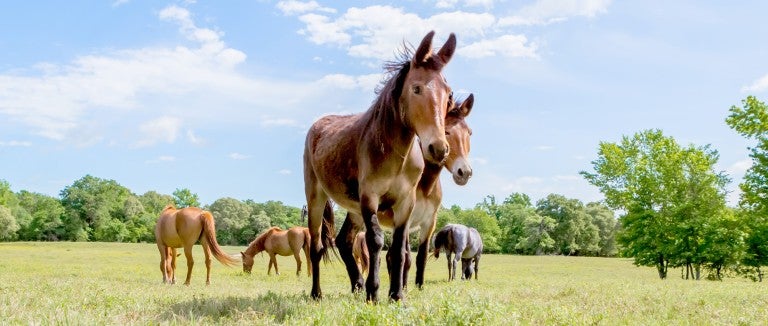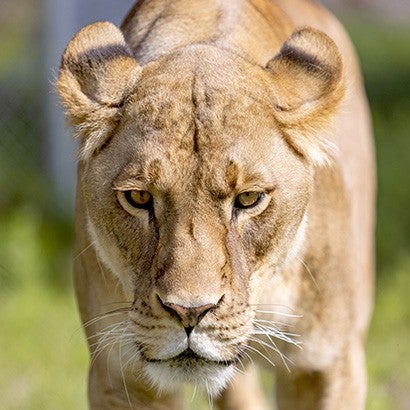
Douala
Rescued from a life of captivity at a roadside zoo in Canada, Douala the lioness now thrives in the sanctuary’s care. If you’re lucky enough to be on the grounds early in the morning before breakfast time, you might get a chance to hear her roar. (Fun fact: You can hear a lion’s roar up to 5 miles away!)
Like many of the sanctuary’s residents, Douala loves the cooler weather in fall and winter. You’ll often find her lounging on her platform, keeping a close eye on her surroundings. She was one of 200 animals rescued from the Saint-Édouard Zoo in Quebec, Canada, after the zoo faced animal cruelty and neglect charges. The big cat area there was poorly designed and constructed, fraught with weakened spots from the animals’ nervous chewing—putting the big cats, their caregivers and the public at great risk.
Now Douala is thriving in her spacious, wooded habitat at Black Beauty Ranch, where she enjoys nutritious meals, naps in the sunshine and “preying” with a variety of enrichment toys.
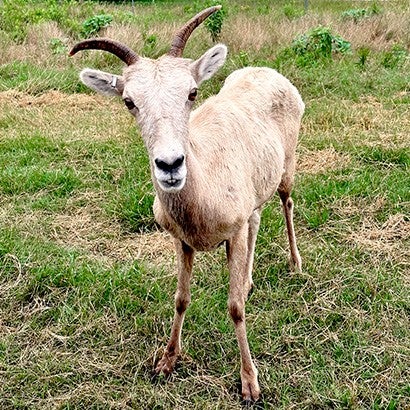
Lily
Nearly every morning, Lily, a petite bighorn sheep, likes to chase whoever’s serving her breakfast. “She’s very playful … kind of obnoxious,” laughs wildlife caregiver Autumn Harmon, who is six months pregnant this particular morning. Harmon holds one hand protectively over her stomach and the other out to discourage Lily from roughhousing. “Lily, we’re not playing this today!” The sheep reluctantly looks for another playmate.
Lily was just a few months old when she arrived in 2019 after being kept as a pet in a college dorm. Her improper diet slowed her growth, leading her to resemble a big goat rather than a bighorn sheep. All female bighorns have slender horns and are missing the telltale curve of the males’, but Lily’s are “still a bit wonky.”
Instead of joining the goat pasture where she’d likely jump the shorter fence, she lives in a 30-acre enclosure the staff call Hilltop, which is closer to her natural habitat with rocks for her to climb. And though there are no other bighorns at the sanctuary, Lily has befriended the emus and deer who live at Hilltop with her.
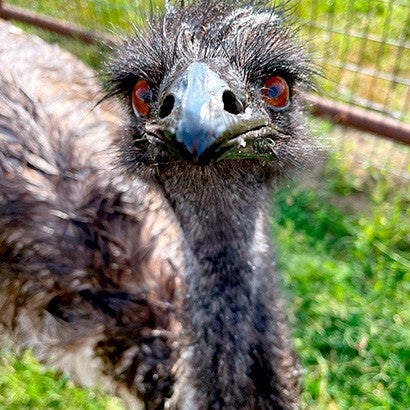
Sparkie
You might say Sparkie stands out in a crowd. Resplendent with fluffy feathers, she towers above her enclosure-mates … because they’re goats and sheep, and she’s an emu.
When Sparkie first arrived at the sanctuary in 2021, caregivers placed her in a 40-acre habitat that houses emus and ostriches. But instead of joining the flock, Sparkie seemed nervous. Formerly kept as a pet, Sparkie never learned how to be an emu or interact with other emus. Staff quickly realized she wouldn’t thrive with the other big birds and moved her to Noah’s Ark, an enclosure with a laidback group of goats and sheep.
Now, Sparkie enjoys life with the four-leggers. She spends much of her time lounging with the sheep under their shade structure and has even been spotted grooming them. But what she loves best is getting sprayed by the hose during hot Texas days—and the caregivers are happy to indulge her.
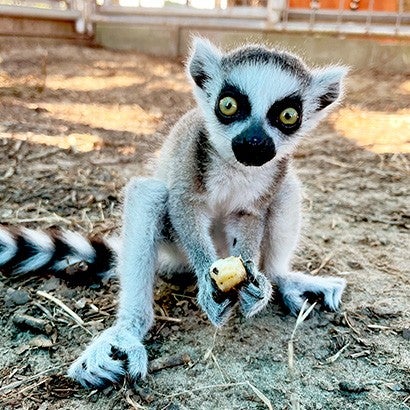
Sprout
The aptly named Sprout (our cover model!) was the smallest youngster among the 10 lemurs who arrived in May 2023 from a shuttered zoo in Puerto Rico.
Rescuers found the lemurs in a dark, concrete-and-wire enclosure at the zoo. Many of the animals suffered from poor nutrition and a lack of enrichment. But after receiving medical care and completing a quarantine period at the sanctuary, the lemurs were released into their 1-acre, forested habitat in October. They quickly started exploring their new home, climbing and hopping from tree to tree.
The sanctuary’s senior director, Sue Tygielski, picked up the animals at the airport and then unloaded them late at night in the pouring rain … all on her first day on the job. She describes the experience as “pretty dramatic and wonderful.”
They arrived skinny and full of parasites, Tygielski recalls, but they now “look like completely different animals. If you took ‘before’ and ‘after’ photos, you wouldn’t even recognize the lemurs because they were so, so skinny.”
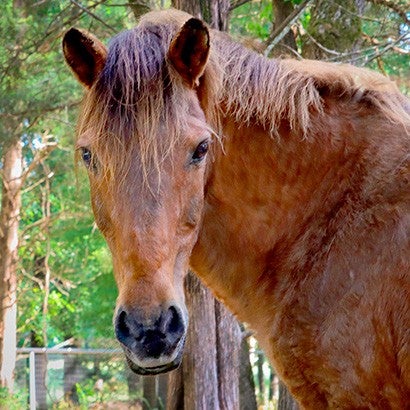
Fabio
One of the sanctuary’s oldest horses, Fabio was notorious for the playful confidence that led to his relocation from Assateague Island on the East Coast in 2012. But after a decade at the sanctuary, the bay horse started to go blind. He became fearful of the people and horses he could no longer see well. When staffers moved Fabio from the grand pasture to the miniature horse pasture for closer observation, caregiver Erin London worked hard to re-acclimate him to her sound, smell and touch.
By the time we visited the sanctuary in June 2023, Fabio had regained some of his formerly demanding personality. Over several days, we heard London repeatedly tell the old horse, “Fabio, I cannot keep scratching you all day. I gotta do my job!” Sadly, Fabio was euthanized in November due to age-related health issues. We’re thankful he could gallop and graze freely for nearly 12 years and beg for back scratches until the very end.
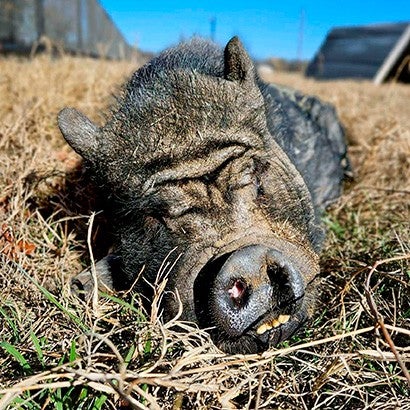
Tulip
With a muffin face, a mouthful of crooked teeth and the physique of a baby rhinoceros, Tulip the potbellied pig isn’t likely to win any beauty contests. That’s fine with her, because she’s got the popularity vote clinched, and that means plenty of her favorite heart-shaped pig treats doled out by her adoring caregivers.
When she was found abandoned in nearby Kaufman County in February 2023, Tulip was severely underweight. Her overgrown hooves curled under, making it painful for her to walk. Now she spends her days basking in the sun, rolling in the hay and nudging her caretakers with her snout when they’re not dispensing food quickly enough.
“She is a gem, a one-of-a-kind sweetheart of a girl,” says caregiver Michelle White. “She does not have a mean bone in that cute little body of hers. We love her dearly.”
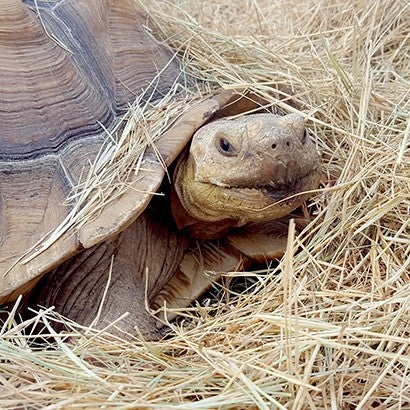
Wally Pauli
At 27, Wally Pauli is the oldest of Black Beauty Ranch’s four sulcata tortoises. He’s also the smallest. That means he has to live separately from the other males so they don’t flip him over. In warm weather, Wally shares his breakfast with Daisy the duck in a yard also occupied by a chicken, a goose and two turkeys.
Wally, who is named for his HSUS rescuer, Dave Pauli, never grew big and has a damaged shell because he wasn’t properly cared for early in life as a pet in Montana. A wildlife veterinary technician persuaded his final owner to turn him over to the HSUS.
Pauli drove him to the sanctuary, where he gets what Ashley Orr, farm animal care manager, says the desert tortoise needs: high temperatures, low humidity, specific levels of ultraviolet light, the opportunity to burrow deep to escape from the heat, and a dry, rough, forage diet.
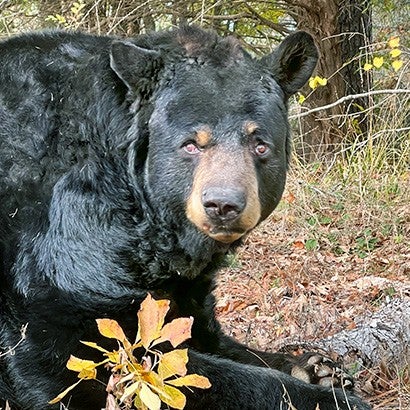
Sammi
The first two decades of his life, Sammi the black bear was transported around the country to perform and pose for photos with an older black bear named Tibor. When their owner retired in 2018 and gave the two bears to Black Beauty Ranch, they did not know how to act like wild animals. Sammi greeted staff who approached with food by putting his paws up or opening his mouth. For the first year and a half, he rarely ventured out into his wooded habitat or used his inground pool.
Sadly, Tibor had to be euthanized due to age-related issues. But soon new black bears arrived at the sanctuary from the wild—Eve, and mother/son Jackie and Russell. Curious, Sammi began roaming his habitat to observe them and communicate.
Today, Sammi behaves more naturally, not as he was trained to act for a traveling show. When Christi Gilbreth, senior coordinator for outreach and development, offers him applesauce for breakfast one morning through the fence, he does not budge. Later, she tries to tempt him with fig cookies. “I’ve put them on the ground so you have to eat them with dirt on them,” she tells him. “You have to be a true bear.” In the past two years, she says, he’s finally started behaving like a “true bear” should.
Want more content like this?
This was written and produced by the team behind All Animals, our award-winning magazine. Each issue is packed with inspiring stories about how we are changing the world for animals together.
Learn MoreSubscribe
